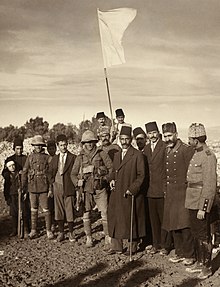 A white flag can be a sign of surrender, but that’s not the only way people have used it throughout history.
A white flag can be a sign of surrender, but that’s not the only way people have used it throughout history.
“It might mean you want to parley,” says James Ferrigan, a consulting vexillologist (i.e., flag scholar) and an officer for the North American Vexillological Association. “It also could mean, in the midst of something, that you want to have a truce. Maybe it’s to bury your dead, and so it’s neither a parley nor a negotiation nor a surrender, it’s just a temporary respite.”
At its most simple, a white flag means: “Don’t attack me.” Military officials have used white flags to protect themselves while making contact with their opponents for a variety of reasons. In addition, civilians have used the flag to signal that they are not combatants at all, and that they have peaceful intentions.
Here’s a look at the different roles the white flag has played in history.
The White Flag’s Unclear Origins
Early examples of the white flag as a symbol of truce or surrender are hard to come by. The Roman historian Livy wrote that, during the Second Punic War (218–201 B.C.), the Carthaginians signaled their desire for peace with “bands of white wool and branches of olive.”
Later, the Roman historian Tacitus recounted a similar incident during a Roman civil war in A.C. 69, writing that one of the warring factions “displayed white bands and olive branches.”
These examples show ancient people using white cloth (along with another notable symbol) to ask for an end to fighting—but why? Ed Watts, a history professor at the University of California, San Diego, explains that Mediterranean people at this time wore white cloth to worship the gods. Displaying it during a war may have been a way of saying: “We are putting ourselves at your mercy, and asking for the protection of the gods,” Watts says.
After that, there aren’t many clear examples of white flags as peaceful symbols until the 16th century. The Oxford English Dictionary and Merriam Webster both date the earliest known use of the term “white flag” to 1578. That year, English sailor George Best published his account of trying to find the Northwest Passage aboard the ship Discoverie. He wrote about encountering Inuit people who made peaceful contact with the ship’s crew by displaying “a white flag made of bladders sowed together with the guts and sinewes of beasts.”
The Dutch jurist Hugo Grotius also mentioned the white flag in his influential 1625 tome on the laws of war and peace. He wrote that displaying a white flag was a way of asking for parley—a discussion between opposing sides.
It’s unclear how the white flag came to signify a desire for peace or parley in the modern era, but it may have been partly due to practicality. Undyed cloth was readily available from soldiers’ clothes and supplies, and visibly distinct from the decorated flags armies carried with them. By the late 19th century, the white flag was a recognizable military symbol in many parts of the world, and played a pivotal roll in the end of the U.S. Civil War.
The White Flag Becomes More Official
When Robert E. Lee decided to surrender to Ulysses S. Grant at the Battle of Appomattox Court House on April 9, 1865, Lee sent a Confederate officer behind Union lines to request a ceasefire so both sides could talk. To telegraph his intentions, the Confederate officer carried a dish towel with him as an impromptu white flag.

The Confederates probably picked that dish towel—which now resides at the Smithsonian National Museum of American History in Washington, D.C.—because it happened to be available at the moment. Even though a white flag had by then become a recognized form of military communication, armies didn’t necessarily go into battle with a predesignated truce flag just in case they needed it.
“That would be detrimental to morale to issue such a thing,” Ferrigan says. “The intent when you [go into battle] is that you’re going to be victorious.”
During the First Hague Conference of 1899, the white flag became a more formal part of international law. An annex to one of the Hague Conventions stated that a person carrying a white flag in order to communicate with a military rival “has a right to inviolability,” or freedom from attack. However, the person would lose this right “if it is proved beyond doubt that he has taken advantage of his privileged position to provoke or commit an act of treachery.”
Militaries continued to use white flags to communicate in the First and Second World Wars. During the so-called Christmas Truce in 1914, the French soldier Gervais Morillon wrote to his parents that German soldiers “waved a white flag and shouted ‘Kamarades, Kamarades, rendez-vous.’”
At the beginning of the Battle of the Bulge in 1944, Nazi officers approached U.S. troops with a white flag to ask if they wanted to surrender. General Anthony McAuliffe’s written reply—“Nuts!”—caused some confusion with the Germans, reportedly leading one U.S. officer to tell them it meant “Go to hell.”
White Flag Appeals From Civilians and Hostages
More recently, prominent incidents involving white flags have involved civilians and hostages trying to protect themselves from military forces. In many of these cases, soldiers have shot and killed noncombatants who sought protection with a white flag.
Politicians and human rights groups have sounded the alarm about such killings, both because the victims were civilians—and because they were waving an international symbol that, for hundreds of years, has signaled a desire truce, surrender and parley, as well as peace, protection and mercy.